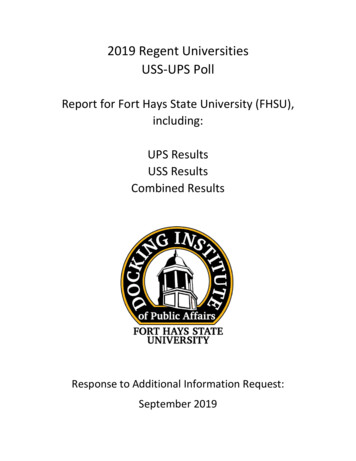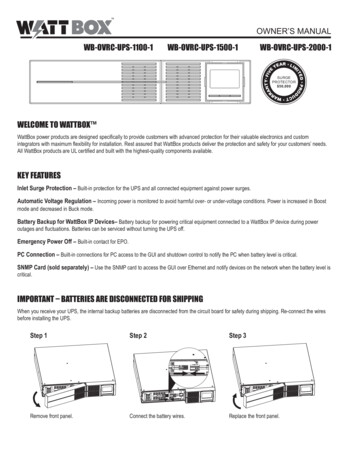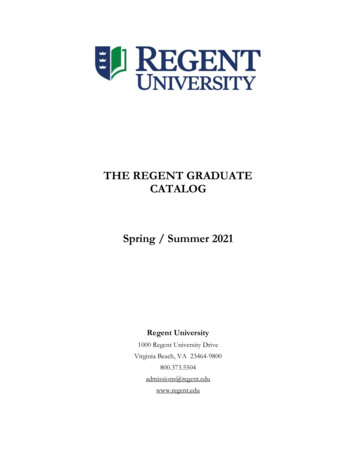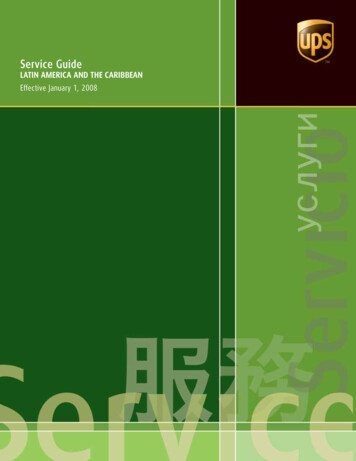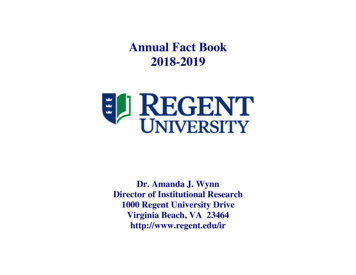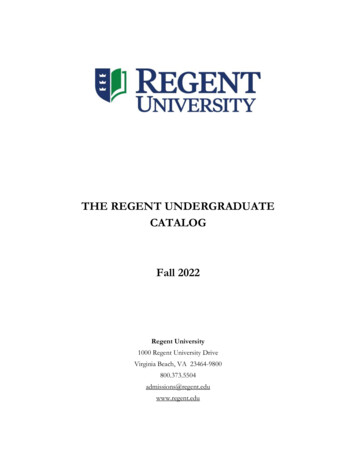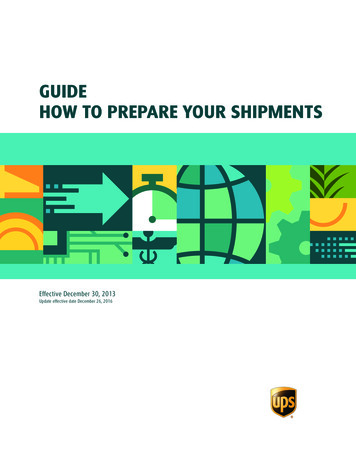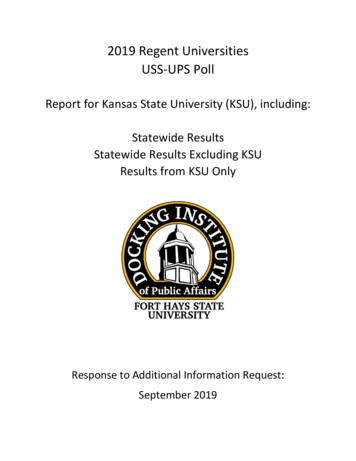
Transcription
2019 Regent UniversitiesUSS-UPS PollReport for Kansas State University (KSU), including:Statewide ResultsStatewide Results Excluding KSUResults from KSU OnlyResponse to Additional Information Request:September 2019
Docking Institute of Public AffairsFort Hays State University600 Park StreetHays, Kansas 67601-4099Telephone: (785) 628-4197FAX: (785) 628-4188www.fhsu.edu/dockingBrett Zollinger, Ph.D.DirectorJian Sun, Ph.D.Assistant DirectorMichael S. Walker, M.S.Research ScholarLuis Montelongo, M.B.ASurvey Center ManagerLynette Ottley, B.A.Administrative SpecialistMission:To Facilitate Effective Public Policy Decision-Making.The staff of the Docking Institute of Public Affairs and itsUniversity Center for Survey Research are dedicated toserving the people of Kansas and surrounding states.
2019 Regent UniversitiesUSS-UPS PollReport for Kansas State University (KSU), including:Statewide ResultsStatewide Results Excluding KSUResults from KSU OnlyPrepared By:Michael S. WalkerDocking Institute of Public AffairsCopyright September 2019All Rights Reserved
ContentsContents . iIntroduction and Methods . 1Introduction . 1Methods . 1Summary . 2Findings. 4Table 1: Years of Employment . 4Table 2: Employment Classification . 5Item Importance and Appreciation of Work Performance . 6Figure 1: Item Ranking . 6Figure 2: Appreciation of Work Performed . 7Work Morale . 8Figure 3: Morale at Work . 8Figure 4: Morale Compared to Two Years Ago . 9Figure 5: Why Morale Has Worsened . 10Wages and Second Job . 11Figure 6: Perception of Current Wages. 11Figure 7: Have Second Job or Other Income. 12Figure 8: Considering a Second Job . 13Figure 9: Reasons for a Second Job. 14Figure 10: Reasons for Continued University Employment . 15Job Satisfaction, Incentives, and Health Insurance . 16Figure 11a: Job Satisfaction (Statewide) . 16Figure 11b: Job Satisfaction (Excluding KSU) . 17Figure 11c: Job Satisfaction (KSU Only) . 17Figure 12a: Incentives or Opportunities (Statewide). 18Figure 12b: Incentives or Opportunities (Excluding KSU) . 19Figure 12c: Incentives or Opportunities (Only KSU) . 19Table 3: Additional Incentives or Opportunities . 20Figure 13: Opinions about Health Insurance . 21Budget Limitation Impacts . 22Docking Institute of Public Affairs: USS-UPS Poll – Kansas State University Reportpg. i
Figure 14: Opinions about Budget Limitation Impacts . 22Table 4: Additional Budget Impact Comments . 23Different Job . 24Figure 15: Looking for Different Job . 24Figure 16: Looking for On- and/or Off-Campus Job . 25Table 5: Additional Comments. 26Appendix: Survey . 27Docking Institute of Public Affairs: USS-UPS Poll – Kansas State University Reportpg. ii
Introduction and MethodsIntroductionUniversity Support Staff (USS) Senates of five Regent Universities asked the Docking Institute ofPublic Affairs to conduct a poll of USS and Unclassified Professional Staff (UPS) employees. Thefive universities included Emporia State University (ESU), Fort Hays State University (FHSU),Kansas State University (KSU), Pittsburg State University (PSU), and Wichita State University(WSU). 1The poll was conducted using Qualtrics on-line survey software. Email addresses for USS andUPS employees employed at the five universities during the spring 2019 semester wereprovided to the Docking Institute. Requests (including a link to an online poll) were sent to USSand UPS employees. The research project was submitted to the FHSU Institutional ReviewBoard (IRB) for review.Poll questions were developed in collaboration with USS Senates. The poll instrument can befound in the Appendix.This report compares results from all poll respondents, respondents from the four otheruniversities, and KSU respondents.MethodsEmails were sent to 8,043 USS and UPS employees at the five universities. The Institutereceived 2,846 completed interviews, providing a response rate of 35.4%. Since the listsprovided by each university included all USS and UPS employees employed during the spring2019 semester, no margin of error is calculated.Email requests, containing links to an online poll utilizing Qualtrics software, were sent to allUSS and UPS employees on the lists. The initial email was sent on March 18, 2019. Additionalemail requests were sent to non-responding employees on March 21, March 26, and April 1.Wichita State provided additional lists of UPS employees on March 28 and April 2. Follow-upemails were sent on April 1 and April 9, respectively.Regarding Kansas State University, emails were sent to 5,070 USS and UPS employees. TheInstitute received 1,419 completed interviews, a response rate of 28%.Data were downloaded into SPSS software for analysis. Email addresses and the names ofemployees were deleted from the SPSS file before analysis began. Only grouped data wereanalyzed, and no attempt was made to link individual responses to individual respondents.1The University of Kansas was invited to participate but declined to do so.Docking Institute of Public Affairs: USS-UPS Poll – Kansas State University Reportpg. 1
SummaryThis report is for Kansas State University. Responses to each question on the USS-UPS Employeepoll conducted in spring 2019 are provided for all five universities (Statewide), four universities(Excluding KSU), and for Kansas State University (KSU Only). In most cases, responses fromthese three groups of respondents are shown in a table or figure. For lengthier sets of seriesquestions, three figures are provided (Statewide, Excluding KSU, and KSU Only).The Docking Institute’s independent analysis of the data set shows the following: Smaller percentages of KSU respondents have worked from 10-14 years, while a largerpercentage of KSU respondents have worked for 20 years or more, when compared to otheruniversities.KSU shows larger percentages (when compared to the other four universities) of both UPShourly wage earners and salary earners.The “amount of pay or compensation” was ranked first (as an important item) among mostrespondents, and “recognition for the work performed” and “additional incentives or perks”were ranked second among many respondents. A slightly larger percentage of KSUrespondents, compared to non-KSU respondents, ranked “professional developmentopportunities” second, while a slightly smaller percentage, compared to non-KSUrespondents ranked “additional incentives or perks” second.Most respondents report that their work is “greatly appreciated” by their immediatesupervisors and co-workers. A smaller percentage of KSU respondents than non-KSUrespondents report that their work is “greatly appreciated” by department heads. A smallerpercentage of KSU respondents than non-KSU respondents also report that their work is“greatly appreciated” and “moderately appreciated” by University administration.Regarding morale at work, most respondents rate their morale as at least somewhatpositive (when considering “somewhat positive” and “extremely positive” responsestogether). A smaller percentage of KSU respondents provide “somewhat positive”responses when compared to other universities.When asked about morale “compared to two years ago,” about 17% of KSU respondentsreport that their morale has “improved,” 38.5% report that their morale has “remained thesame,” and 44.2% report that their morale has “worsened.” Among non-KSU respondents,24.1% report that their morale has “improved,” 37% respondents report that their moralehas “remained the same,” and 41.6% report that the morale has “worsened.”Among respondents reporting that their morale had worsened, KSU stands out with a muchlarger percentage of responses regarding “salary increases haven’t kept up with increasedcosts” as reasons for worsened morale, compared to other universities.When asked if wages are “reasonable” for the work performed, slightly smaller percentagesof KSU respondents find their wages “reasonable” and “somewhat reasonable” whencompared to respondents from other universities.More than a third of KSU respondents report having a second job. About a third of non-KSUrespondents report the same.Docking Institute of Public Affairs: USS-UPS Poll – Kansas State University Reportpg. 2
A slightly larger percentage of KSU respondents than respondents from other universitiesreport “considering taking a second job.”When asked why they have a second job or are considering one, about 20% of allrespondents report a need for “additional discretionary income,” about 40% report a needto “pay down debts and bills,” and about 40% report a need to “better provide for families.”Responses do not differ from KSU and non-KSU respondents.Larger percentages of non-KSU respondents (Excluding KSU) than respondents from KSUreport that they remain at their university for the “enjoyment of work” and “educationdiscounts.”Regarding job satisfaction, larger percentages of KSU respondents than respondents fromother universities “disagree” and “strongly disagree” with the statements “I have a fairchance of advancement” and “I have fair chance for salary increases.”Regarding incentives or opportunities, most (more than 50%) or nearly most respondentsfind “Improved Health Care Benefits,” “flex-time or flexible hours,” and “on-the-jobtraining” at least “moderately important” regardless of university grouping. A slightly largerpercentage of non-KSU respondents than KSU respondents consider “transportation assistance” as“not at all important.”When asked about the value of health insurance, responses from KSU and non-KSUrespondents do not differ much, although a slightly larger percentage of KSU respondentsthan non-KSU respondents report that they do not use State of Kansas Health Insurance.When asked about budget limitation influencing their work, larger percentages of KSUrespondents than non-KSU respondents report “staff reduced: unfilled positions” and “staffreduced: unable to fill open positions at current salary/wage levels” as impacts.When asked if they are currently looking for a new job, a larger percentage of KSUrespondents report “yes” when compared to respondents from other universities.A slightly smaller percentage of KSU respondents report looking for an off-campus job and alarger percentage of KSU respondents report looking for an on-campus job, when comparedto respondents from other universities.When asked to provide additional comments, 19.5% of all (Statewide) respondents and16.8% of non-KSU (Excluding KSU) respondents report that “wage increases/wage increaseschedule/yearly cost of living increases are needed.” A much larger percentage of KSUrespondents (21.7%) report the same.Docking Institute of Public Affairs: USS-UPS Poll – Kansas State University Reportpg. 3
FindingsThis section of the report provides percentage responses to each question in the poll.Questions were grouped by theme and do not necessarily follow the flow of the poll questions(see the Appendix).The tables and figures below show responses for all five universities (Statewide), all universitiesexcept for Kansas State University (Excluding KSU), and for Kansas State University (KSU Only).The table below shows that KSU respondents do not differ much with regard to years ofemployment when compared to all universities or the other four universities, although smallerpercentages of KSU respondents have worked from 10-14 years, while a larger percentage ofKSU respondents have worked for 20 years or more, when compared to other universities(Excluding KSU).Table 1: Years of EmploymentPercentages ShownStatewide(n 2,842)0-4 years5-9 years10-14 years15-19 years20 years or moreTotal33.619.213.610.922.7100Excluding KSU(n 1,426)KSU Only(n 00Docking Institute of Public Affairs: USS-UPS Poll – Kansas State University Reportpg. 4
The table below shows respondents by employment classification. The largest percentages ofrespondents (statewide) are Unclassified Professional Staff (UPS) – Salary earners andUniversity Support Staff (USS) – Hourly Wage earners.KSU shows larger percentages (when compared to the other four universities) of both UPShourly wage earners and salary earners.Table 2: Employment ClassificationPercentages ShownUnclassified Professional Staff (UPS) - Hourly WageUnclassified Professional Staff (UPS) - SalaryUniversity Support Staff (USS) - Hourly WageUniversity Support Staff (USS) - SalaryI Don't KnowTotalStatewide(n 2,846)Excluding KSU(n 1,419)KSU Only(n .443.429.95.71.6100Docking Institute of Public Affairs: USS-UPS Poll – Kansas State University Reportpg. 5
Item Importance and Appreciation of Work PerformanceFigure 1 shows responses to four items. Respondents were asked to rank each according toimportance, from first to fourth. The items were: Recognition for the work you performAmount of pay or compensationAdditional incentives or perksProfessional development opportunitiesThe figure shows that the “amount of pay or compensation” was ranked first among mostrespondents, regardless of university.“Recognition for the work you perform” and “additional incentives or perks” were rankedsecond among about a third of respondents.A slightly larger percentage of KSU respondents, compared to respondents from other universities,ranked “professional development opportunities” second, while a slightly smaller percentage, comparedto respondents from other universities, ranked “additional incentives or perks” second.Figure 1: Item RankingDocking Institute of Public Affairs: USS-UPS Poll – Kansas State University Reportpg. 6
Figure 2 shows responses to statements addressing the work performance appreciation byvarious groups and individuals. The groups and individuals include co-workers, immediatesupervisors, department heads, and university administrators. The statements include “mywork is unappreciated,” “my work is moderately appreciated,” “my work is greatlyappreciated,” and “this item does not apply to me.”Figure 2 shows that most respondents report that their work is “greatly appreciated” by theirimmediate supervisors and co-workers.KSU stands out with a smaller percentage of respondents reporting that their work is “greatlyappreciated” by department heads when compared to other universities.Smaller percentages of KSU respondents also report that their work is “greatly appreciated”and “moderately appreciated” by University administration when compared to otheruniversities.Figure 2: Appreciation of Work PerformedDocking Institute of Public Affairs: USS-UPS Poll – Kansas State University Reportpg. 7
Work MoraleThis section of the report addresses work morale directly. Figure 3 shows responses to thequestion “generally speaking, how do you rate your morale at work?” Answer options rangedfrom “extremely positive” to “extremely negative.”Figure 3 shows that most respondents rate their morale as at least somewhat positive (whenconsidering “somewhat positive” and “extremely positive” responses together).KSU respondents provide a smaller percentage (40.9%) of “somewhat positive” responsescompared to respondents from other universities (45.6%), and a slightly larger percentage of“somewhat negative” responses (21%) when compared to other universities (17.2%).Figure 3: Morale at WorkDocking Institute of Public Affairs: USS-UPS Poll – Kansas State University Reportpg. 8
Figure 4 shows responses to a question asking “compared to two years ago, would you say yourmorale has improved, remained the same, or worsened?”Among non-KSU respondents, 24.1% report that their morale has “improved,” 37% respondentsreport that their morale has “remained the same,” and 41.6% report that the morale has“worsened” compared to two years ago.About 17% of KSU respondents report that their morale has “improved, 38.5% report that theirmorale has “remained the same, and 44.2% report that their morale has “worsened” during thepast two years.Figure 4: Morale Compared to Two Years AgoDocking Institute of Public Affairs: USS-UPS Poll – Kansas State University Reportpg. 9
Respondents indicating that their morale has worsened compared to two years ago(represented by the grey bars in the previous figure) were asked follow-up questions about whymorale has worsened. Responses included “salary increases haven’t kept up with increasedcosts,” “had to take on additional work duties with no/minimal increases in pay,” “morale ofthose around me has worsened,” and “layoffs have created uncertainty about the future of myposition.”The figure below shows all four statements and all three groups of universities.KSU stands out with much larger percentage of responses regarding “salary increases haven’tkept up with increased costs” as reasons for worsened morale, compared to other universities.A slightly larger percentage of KSU respondents identify “additional work duties withno/minimal increases in pay” as a reason for worsened morale, compared to other universities.On-the-other-hand, larger percentages of non-KSU respondents report that “morale of thosearound me has worsened” and “layoffs have created uncertainty about my position” as reasonsfor worsened morale when compared to KSU respondents.Figure 5: Why Morale Has WorsenedDocking Institute of Public Affairs: USS-UPS Poll – Kansas State University Reportpg. 10
Wages and Second JobThis section of the report addresses wages and a second job (if workers have a second joband/or if they have considered one).Figure 6 shows responses to the question “how do you rate your salary or hourly wage withregard to the work you currently perform?” Answer options ranged from “extremelyreasonable” to “extremely unreasonable”.The figure below shows that smaller percentages of KSU respondents find their wages“reasonable” and “somewhat reasonable” when compared to respondents from all universitiesor the other four universities.Figure 6: Perception of Current WagesDocking Institute of Public Affairs: USS-UPS Poll – Kansas State University Reportpg. 11
Figure 7 shows responses to a question asking “do you (yourself) have a second job or othermeans of income?” The figure shows that 33.9% of non-KSU respondents and 38.4% of KSUrespondents report having a second job or other means of income.Figure 7: Have Second Job or Other IncomeRespondents answering “no” to the question above were asked the question “are youconsidering getting a second job (or considering some other option) to increase your income?”Figure 8 (next page) shows that more than one-third answered “yes” to this question.Docking Institute of Public Affairs: USS-UPS Poll – Kansas State University Reportpg. 12
KSU has a larger percentage of respondents reporting that they are considering a second job(44.2%) when compared to all universities (42.1%) and the other four universities (40.1%).Figure 8: Considering a Second JobRespondents with a second job (“yes” Figure 7) and those considering a second job (“yes”Figure 8) were asked the question “of the following, which BEST describes the reason you havetaken a second job or are considering a second job?”Answer options included to “be able to better provide for family,” “help to pay downdebts/bills,” and “be able to have additional discretionary income (i.e., to spend on vacations,upgraded car, etc.).”Figure 9 (next page) shows essentially no difference among respondents from KSU and non-KSUuniversities. About 20% of respondents have a second job or are considering taking a secondjob to “have additional discretionary income,” about 40% have a second job or are consideringone to “pay down debts and bills,” and almost 40% have a second job or are considering one to“better provide for families.”Docking Institute of Public Affairs: USS-UPS Poll – Kansas State University Reportpg. 13
Figure 9: Reasons for a Second JobRespondents with a second job (“yes” Figure 7) and those considering a second job (“yes”Figure 8) were also presented with the following statement and question:“You mentioned that you have a second job or that you are considering takinga second job. Regarding your job with the University, which of the followingreasons have encouraged you to remain employed there?”Respondents were presented the list of the following statements and asked if they agree ordisagree with each (recorded as “yes” or “no”). I earn a better salary than a comparable job in the private sectorThe stability in employmentI need the health insuranceI need access to the education discounts offered (i.e. tuition waivers) for self/dependentsI am close to retirement ageI enjoy the work so much that I remainFigure 10 (next page) shows the responses to these statements ranked by largest to smalleststatewide “yes” responses.Docking Institute of Public Affairs: USS-UPS Poll – Kansas State University Reportpg. 14
Figure 10: Reasons for Continued University EmploymentFigure 10 shows that larger percentages of non-KSU respondents (Excluding KSU) thanrespondents from KSU report that they remain at their university for the “enjoyment of work”and “education discounts.”Docking Institute of Public Affairs: USS-UPS Poll – Kansas State University Reportpg. 15
Job Satisfaction, Incentives, and Health InsuranceThis section of the report addresses job satisfaction, incentives or opportunities that might beof interest to employees, and opinions about health insurance.Regarding job satisfaction, respondents were presented with a number of statements andasked to respond to each with answer options ranging from “strongly agree” to “stronglydisagree.” The statements included the following: I enjoy the things I do at workI have a generally positive work environmentI am sufficiently trained to complete my required job dutiesI have a reasonable workloadI have a fair chance of advancement in my jobI have a fair chance for future salary or wage increasesFigures 11a, 11b, and 11c show responses to the statements ranked by “agree” and “stronglyagree” combined. Figure 11a shows responses from all five universities (Statewide).Figure 11a: Job Satisfaction (Statewide)The figure above shows that most respondents “agree” with the statement “I enjoy the things Ido at work” (51.6%), while a third (33.8%) “strongly agree” with the statement.Docking Institute of Public Affairs: USS-UPS Poll – Kansas State University Reportpg. 16
Figure 11b shows responses from four universities (Excluding KSU). Figure 11c shows responsesfrom KSU. Responses do not differ greatly when comparing respondents from all universities,respondents from non-KSU universities, and respondents from KSU.Larger percentages of KSU respondents than respondents from other universities “disagree”and “strongly disagree” with the statements “I have a fair chance of advancement” and “I havefair chance for salary increases.”Figure 11b: Job Satisfaction (Excluding KSU)Figure 11c: Job Satisfaction (KSU Only)Docking Institute of Public Affairs: USS-UPS Poll – Kansas State University Reportpg. 17
Figures 12a, 12b, and 12c show responses to the series of statements regarding incentives oropportunities that might be of interest to employees. Respondents were asked to respond toeach with answer options ranging from “extremely important” to “not at all important.” Theincentives or opportunities are listed below: Flex-time or flexible hoursOn-the-job trainingTransportation assistance (such as a ride sharing program)Childcare assistance (such as financial assistance or care at work)Improved healthcare benefitsFigures 12a, 12b, and 12c show responses to the statements ranked by “very important” and“extremely important” combined.Figure 12a shows responses from all five universities (Statewide).Figure 12a: Incentives or Opportunities (Statewide)The figure above shows that 39.6% of all respondents find “Improved Health Care Benefits”“extremely important,” while 32.2% find improved benefits “very important.”Docking Institute of Public Affairs: USS-UPS Poll – Kansas State University Reportpg. 18
Figure 12b shows responses from employees from four universities (Excluding KSU). Figure 12cshows responses from employees from KSU.Figure 12b and Figure 12c show similar responses from non-KSU and KSU respondents.A slightly larger percentage of non-KSU respondents than KSU respondents consider“transportation assistance” as “not at all important.”Figure 12b: Incentives or Opportunities (Excluding KSU)Figure 12c: Incentives or Opportunities (Only KSU)Docking Institute of Public Affairs: USS-UPS Poll – Kansas State University Reportpg. 19
Respondents were asked to provide another incentive in a text box. Table 3 shows commentscollapsed into 22 categories. (NOTE: Some respondents provided more than one incentive oropportunity. The categories below show the first incentive/opportunity listed.)Table 3: Additional Incentives or OpportunitiesPercentages of ResponsesStatewide(n 927)Excluding KSU(n 451)KSU Only(n 476)Promotion Schedule/Merit Schedule/Annual Raises13.310.216.2Immediate Base Pay Increase12.812.613.0Paid or Reduced Parking Fee8.78.98.6Tuition Assistance Improvement/Loan Repayment8.18.28.0Financial Incentives or Bonuses for Extra Work7.36.48.2Additional Paid Time Off/Paid During Semester Breaks6.68.05.3Working Remotely/Telecommute5.85.85.9Appreciation for Work Performed/Better Work Environment5.36.74.0Professional Development Opportunities5.14.95.3Paid or Reduced Recreation or Entertainment Fees5.06.23.8Additional Incentives/OpportunitiesImproved Health Care Insurance4.44.04.8Retirement Plan or 401k Options/Options for Part-Time Work3.83.83.8Upper Admin. Planning/Understanding of Our Entities & Jobs2.32.71.9Hire Additional Staff/Fill Vacant Positions1.92.21.7Parent or Child Leave Policy1.71.61.9Other Comments1.61.12.1Four Day Work Week1.51.81.3Work Cell Phones/Work Items Provided1.31.31.3Flexible Working Hours/Flex-Time1.21.11.3Additional Office/Work Space or Improve Work Stations0.90.41.3Time for Expercise During Workday0.81.30.2Reduced Fees for On-Campus Meals0.60.90.4Total100100100The table above shows that 13.3% of all (Statewide) respondents and 10.2% of non-KSU(Excluding KSU) respondents identify a “defined promotion schedule, a merit schedule, orannual raises” (or similar co
five universities included Emporia State University (ESU), Fort Hays State University (FHSU), Kansas State University (KSU), Pittsburg State University (PSU), and Wichita State University (WSU). 1. The poll was conducted using Qualtrics on-line survey software. Email addresses for USS and
